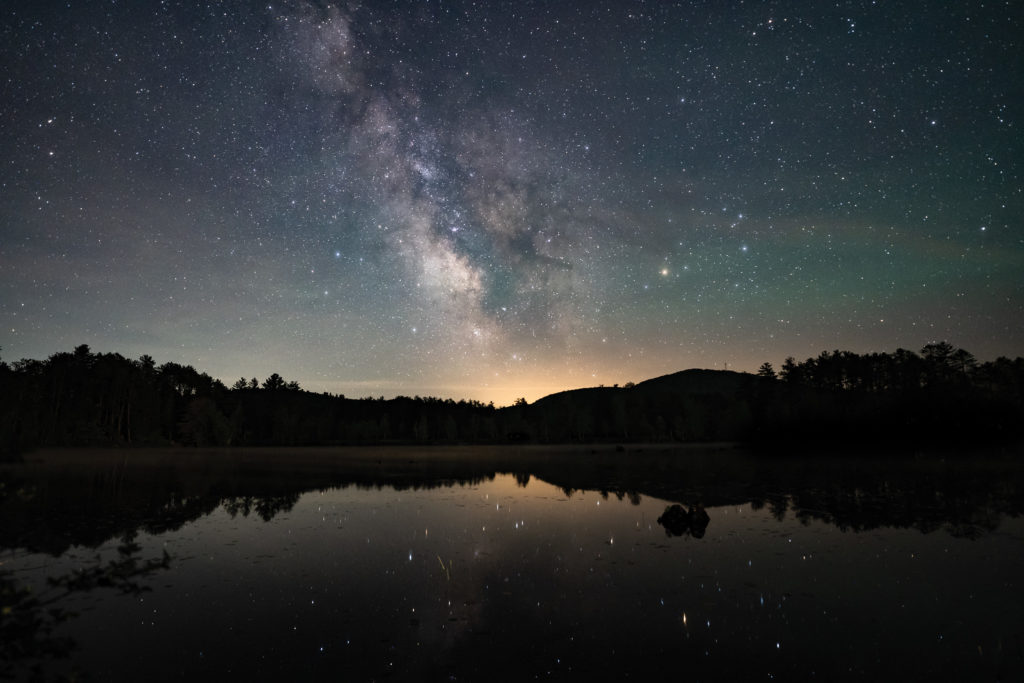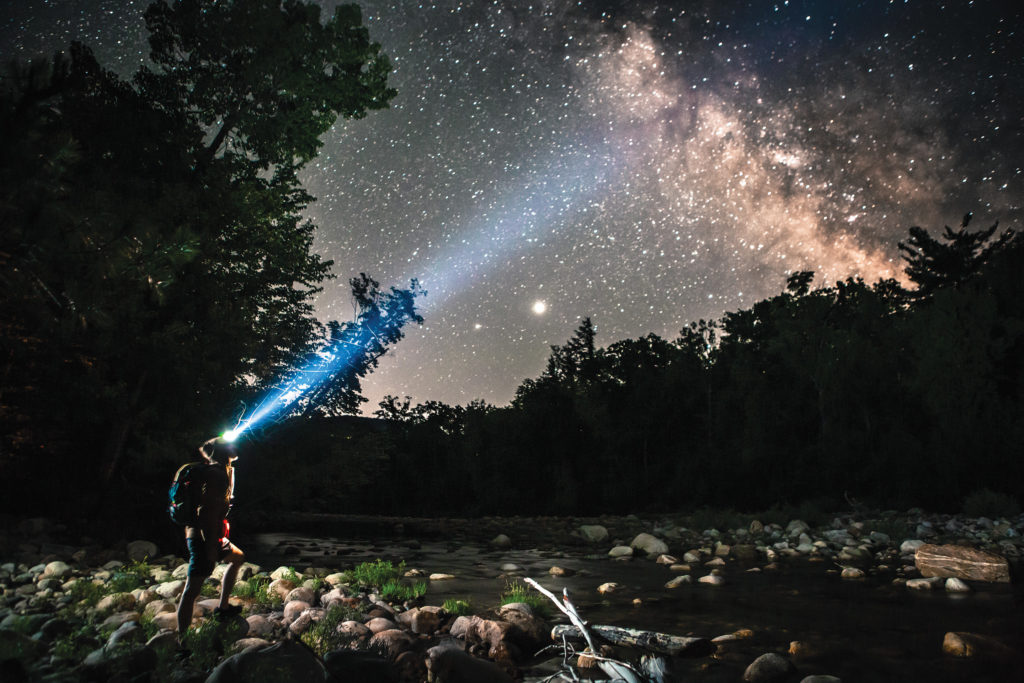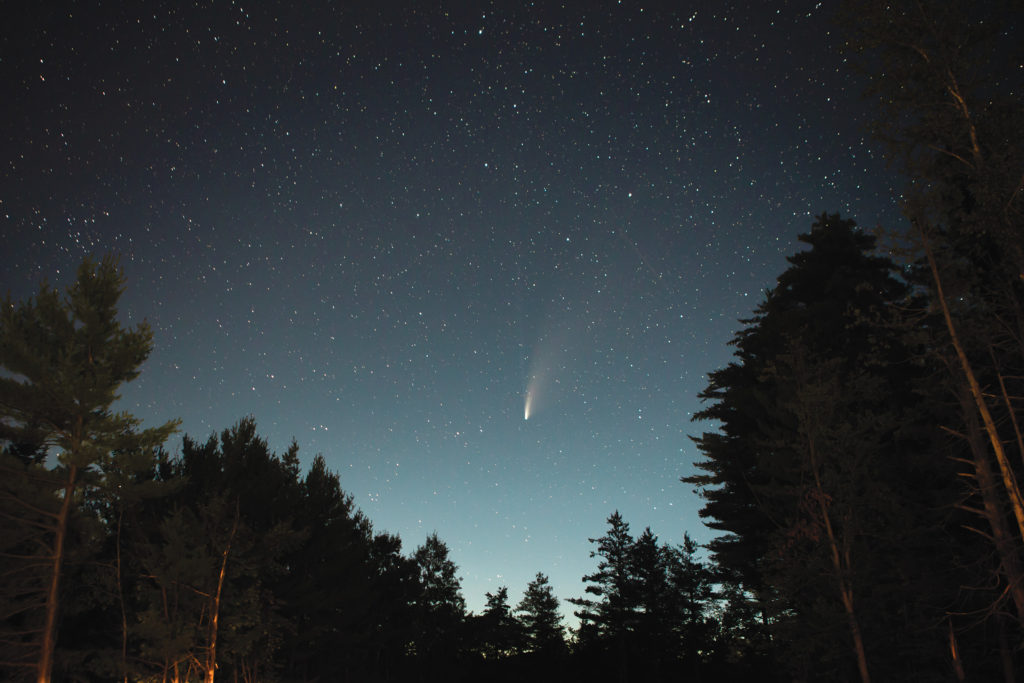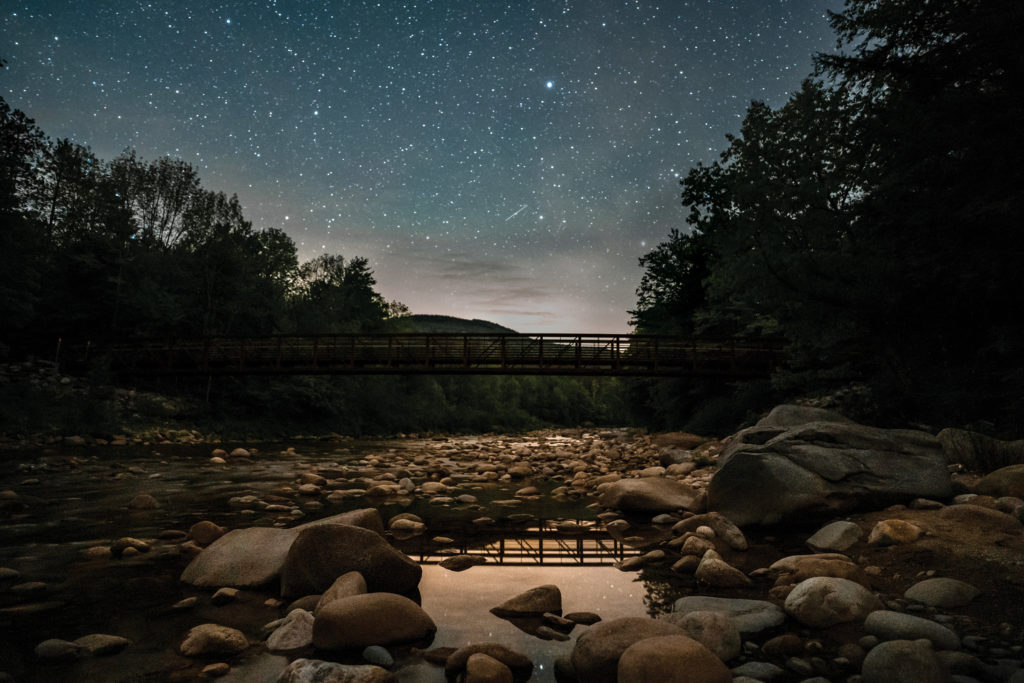A Guide to Maine Stargazing
Where to find the darkest skies, tips and tricks for budding astrophotographers, and future celestial events to watch for.

A Guide to Maine Stargazing
Where to find the darkest skies, tips and tricks for budding astrophotographers, and future celestial events to watch for.
by Jenny O’Connell
Photography by Andy Gagne
Issue: August 2022
THE LAST DARK SKY IN THE EAST
Chasing Stars in AMC’s Maine Woods International Dark Sky Park
You know how it feels in your body: the deep inhale. The slack in your jaw, the melt of your shoulders. Your eyes widen. Your blood pressure drops. Something releases in you, soothed by the dark. As you gaze at the millions of stars twinkling above the horizon, you remember what you’ve forgotten: that you are actually quite small. Your ancestors stood and looked up at these same constellations. This sky is your connection to every other culture on the planet. To every other human being.
“You can look from the water to the forest to the sky, and it’s always looked like this,” says Steve Tatko, senior director of Maine Conservation and Land Management for the Appalachian Mountain Club (AMC). “It’s never not been dark.”
We’re standing on the shore of Second Roach Pond on AMC conservation lands. That’s the name folks use nowadays, but what we’re really standing on is an esker—a long, winding ridge of stratified gravel left by the Laurentide Ice Sheet 26,000 years ago—the dividing line between two water-sheds and one of the last places in the world that was colonized by people. This campsite is a short canoe paddle from AMC’s Medawisla Lodge—medawisla is the Wabanaki word for “loon.” As night falls across the water, the birds call out with wild bursts of song, making their presence known.

“This is a forest that has developed in the presence of the Wabanaki people. You can stand on these riverbanks and see the same sky they did 7,000 years ago,” says Tatko, reminding me that this place, considered protected wilderness, has not evolved without the influence of humans. Western society’s narrative of “untouched” and “pristine” landscapes robs First Nations people of their sovereignty and agency in shaping the place they’ve occupied for nearly 12,000 years, and creates barriers that separate us from the natural world. “Who thought we’d need to protect the vista of the sky?” says Tatko. “That just tells you how far we’ve fallen in our ability to value the world around us. But I think it’s an incredibly important step to taking ownership over our own ability to connect with who we were, and who we still are.”
In 2021 the AMC Maine Woods property became the first International Dark Sky Park in New England. Situated at the edge of the North Maine Woods—an expanse of more than 14,000 square kilometers of largely uninhabited forest land that stretches from Monson, Maine, to the border of Canada—the sky we’re standing under and the Katahdin Woods and Waters National Monument, which was designated an International Dark Sky Sanctuary in 2020, are the only protected dark sky areas in the region. With much of the Northeast converted for urban development, this forest has been identified as an important hotspot for habitat connectivity and climate change resilience. Still, it’s at risk: much of the surrounding land is owned by timber companies. “The scariest thing you can ever do from a conservation perspective is look at the parcel data,” Tatko says. “This is the last place in the East where it’s big.”
AMC is the North America’s oldest conservation group, but it wasn’t always that way. The organization, which supports outdoor recreation and maintains 1,800 miles of trails from Maine to D.C., began as a hiking club aimed at getting people outside. Over time, the idea emerged to develop a sense of stewardship through interaction with place. From lodges with soft beds and three meals a day to rustic campsites like this one, the AMC provides access to the outdoors for people of all ages and abilities based around a simple calculation: if you love something, you will protect it.

In Maine the AMC holistically manages 75,000 acquired acres in the North Maine Woods and the 100-Mile Wilderness for biological conservation, sustainable forestry, backcountry recreation, and environmental education. Now that conservation lens is being applied to the night sky.
Founded in 2001, the International Dark Sky Places program encourages communities, parks, and protected areas around the world to be stewards of the night. Places are awarded a designation through a rigorous application process that involves a thorough inventory, responsible lighting policies, and public education. Jenny Ward, who has been stargazing in the Greenville region for over 50 years, is leading the Dark Sky certification process for AMC. “Our planet, and the evolution of species on this planet, revolves around periods of dark and light,” Ward says. “It’s how people learned to survive—cycles of the moon, navigation of the stars. We lived our lives with that cycle of day and night. It hasn’t been until the last 100 years or so that we created a society that’s built around keeping the lights on all the time.”
Consider the impacts of lighting up the night. For plants and animals, the dark supports rhythms of reproduction, food hunting, sleep, and protection. Light pollution changes the habits of nocturnal animals, leaves prey more susceptible to predators, muddles migration patterns for birds, sea turtles, and butterflies who navigate by the stars and moon, and can even affect the seasonal cycle of deciduous trees. Artificial light at nighttime poses health risks to humans, too: when our circadian rhythm is disrupted we produce less of the health-inducing hormone melatonin, leaving us at higher risk for obesity, depression, sleep disorders, diabetes, and breast cancer among other issues.

The night sky inspired our ancestors’ forays into science, literature, art, religion, and philosophy. Now, according to Ward, 80 percent of people living in the world cannot see the Milky Way, and 99 percent of the U.S. population lives somewhere impacted by light pollution—which means that our newest generations are losing touch with our common and universal heritage. “We had one group of students from New York City,” Ward says. “They didn’t realize they had stars above New York. They didn’t know they existed everywhere.”
“We get so subconsciously used to human interference in our audiovisual realities,” says Tatko. “There are people who are afraid of the absence of those things. That feels like a big injustice, that we haven’t been able to empower them to embrace that level of discomfort. It feels like a taking of a right, in a way—the right to be in the dark.”
Luckily, there’s a quick and easy fix to the problem—all we have to do to preserve the night sky is switch off the lights.
Okay, it’s not quite that simple, but it’s close. Assessing and reducing outdoor light impact at home, spreading the word, advocating for dark skies in your community, becoming an AMC or International Dark-Sky Association (IDA) member, and participating in dark sky research as a citizen scientist are all great ways to get involved. The nonprofitDark Sky Maine (darkskymaine.com) organizes seasonal “Star Parties” that connect people to the night sky, and educates communities on safe and efficient lighting. “Take a look at where you’re living, and where you’re working. Make those simple changes,” Ward says. “Dark sky lighting is beautiful light. It’s easy on your eyes. It’s still doing the task you’re asking it to do. It’s less consumptive, and less costly.” The IDA’s website (darksky.org) offers resources for assessing inefficient, poorly installed, and unnecessary outdoor lighting at your home and workplace and installing dark-sky-friendly lighting—products that keep lights pointed at the ground, light only their intended target, reduce harmful blue-rich white light, and use less energy. “It makes sense now in a way it didn’t a little bit ago,” Ward says, citing high energy costs. As part of their Dark Sky Park designation, AMC has partnered with the North Maine Woods association and the Katahdin Ironworks and Hedgehog checkpoints to install dark-sky-compliant lighting. They’ve also collaborated with the town of Greenville to change 188 streetlights, which saved the town over $10,000 in the first year. This June at their annual town meeting, Greenville voted to make changes in their signage and outdoor lighting ordinances to align with dark sky guidelines.

But why stop there? “Wouldn’t it be great to have a state that recognized the value of dark skies?” Ward says. “That would be incredibly cool, to be a dark sky state.”
Tonight, as I stand under the last exceptionally dark skies east of the Mississippi, it all feels very personal. The times I have felt most deeply connected to the world and my place within it are the times I have been sitting or walking under a starry sky. Growing up, stargazing was something my family did to come together at the end of the day. I remember dark skies and blazing shooting stars, laughter, gasps of awe. As people around us built bigger houses and developed the land, the stars became muffled by patio lights, and inside me bloomed a deep grief. We had forgotten how to sit still and watch the sky without thumbing through yesterday’s photos. How to notice the birds gone quiet, the night rushing in.
It hasn’t occurred to me until now that this is reversible.
“If we don’t have the stage, the show can’t go on,” Tatko says. “We are conserving this space, and this stage, and trying to do right by it. It feels like the best we can do is carry forward in some way, so that other people will find value in it in ways that we may not understand right now.” As he talks about future generations, I’m thinking too about what it is to be young under the night sky. How stars remind us of our own insignificance. How that can be a relief.
Last night, a couple miles south of here, at Horseshoe Pond, we watched, breathless and hopeful, as the first constellations appeared on the southern horizon. We stayed up for hours, shivering in the cold, to watch the night sky come alive with stars. It’s cloudy tonight, and warm. The black flies are biting, and my eyelids are growing heavy. But I am aware of the privilege I have in this moment, and the people who made it possible. Soon, I will crawl into my tent and sleep, as the world falls comfortably dark.

STARGAZING TIPS
Follow these suggestions from AMC’s Jenny Ward to make the most of your stargazing experience.
- Check the weather for clear skies before you go.
- Check the phases of the moon. The closer you are to a new moon, the darker the sky will be, and the brighter the stars.
- Scope out the darkest areas using a light pollution map—see lightpollutionmap.info— and pick a park, hilltop, or body of water with a large horizon that will give you an unobstructed view of the sky.
- Bring a blanket or a chair. A telescope or a pair of binoculars can be handy for taking a closer look.
- Use a headlamp or a flashlight with a red light setting—it’ll take your eyes less time to adjust to the dark.
- Download star-viewing apps that help you identify different constellations.
- If you’re uncomfortable in the dark, explore your star spot during the daytime so it feels familiar. Venture out at dusk when it’s still light. Go with a friend. A lot of people are afraid of the dark, but this is something you can overcome—and it’s worth it!

BECOMING AN ASTROPHOTOGRAPHER
Getting a clear picture of the night sky is challenging, but it can be done with a well-chosen location, the right camera settings, and some patience! Here are a few pro tips from photographer Andy Gagne.
WHAT YOU WILL NEED
• Digital camera with manual mode
• Wide-angle lens
• Tripod
TIP 1:
Location, location, location! Choose a stargazing spot with minimal light pollution—away from city lights and during the new moon. Scouting your location ahead of time during the day will make creating a composition in the dark much easier. Apps such as PhotoPills and SkyView are great tools for gathering information about the night sky, including the current phase of the moon, sunrise and sunset times, and where and when the Milky Way will be visible.
TIP 2:
Set up your camera for success. Here’s how to adjust your camera settings—shutter, aperture, and ISO—to allow optimal light into your camera’s sensor:
• With your camera on a tripod, set a long exposure (e.g., 15 seconds). Be careful not
to touch or move your camera during the exposure. Even the gentle press of the shutter will blur the image. To avoid this, use a remote trigger or set your camera to a 5-second timer. If you set your exposure for too long, you’ll notice star trails from the Earth’s rotation.
• Use the widest (lowest number) aperture your lens will allow (e.g., F1.4, F1.8, F2.8, F4).
• In a normal daylight setting there’s enough light for you to use a low ISO. However, at night you’ll likely need to have the ISO at a higher setting than normal (e.g., 1000–6400). Your camera’s sensor is more sensitive to light at a higher ISO, but if your ISO is too high you will notice “noise” or “grain” in your image. The lower the ISO, the better the quality. Experiment with your camera’s ISO to find the right balance.
• Set your camera to shoot in RAW format. RAW files are very large files that hold a lot of information, which will allow you to adjust and edit your photos as needed later on.
• For crisp and focused stars, set your lens in manual mode to infinity. On most lenses there is an infinity symbol at the end of your focus ring.
Depending on your camera and lens, your settings will vary. Getting it right will take some trial and error.
COMPOSITION
Think about what makes an interesting photograph. How can you frame the stars with trees, water, mountains, or other landscape features around you? Perhaps you have outdoor gear with you, such as a paddle, a boat, or a tent lit up from the inside. You can even get a friend to stand very still in the frame, and light them for a few seconds during the shot with a headlamp or flashlight.
Point your camera toward the south to catch the Milky Way, and enjoy the magic of the night sky!
7 STUNNING PLACES TO STARGAZE ACROSS MAINE
- Katahdin Woods and Waters National Monument, Millinocket
- AMC Maine Woods International Dark Sky Park, Greenville (The Dark Festival: October 16–23, 2022)
- Acadia National Park (Night Sky Festival: September 21–25, 2022)
- Coastal Rivers Conservation Trust, Damariscotta
- Cobscook Bay, Dennysville
- Aroostook County
- Blueberry Pond Observatory, Pownal

RAINY DAYS AT THE SOUTHWORTH PLANETARIUM
Can’t see the stars because of weather? The University of Southern Maine’s Southworth Planetarium offers shows Monday through Saturday for children and adults. Tag along on the GAIA Space Mission, walk on the moon, romp with dinosaurs, or celebrate solstice at Stonehenge. If you’re curious about astronomy, you can get your questions answered by staff astronomer Edward Herrick-Gleason or sign up for the Daily Astronomer at usm.maine.edu/planet.
CELESTIAL EVENTS TO WATCH FOR
PERSEID METEOR SHOWER | AUGUST 11–12, 2022
This highly anticipated annual meteor shower lights up the sky at a rate of 50 to 100 meteors per hour. This year, you’ll need to set an alarm for 2 to 3 hours before dawn because the Perseid’s peak coincides with the full moon on August 12th—the last of three supermoons in 2022.
ORIONID METEOR SHOWER | OCTOBER 21–22, 2022
Originating from dust grains left behind by the world-famous Halley’s Comet, the Orionid occurs annually from October 2 to November 7, peaking this year on the night of October 21 and in the early morning of the 22nd. A crescent moon will leave the sky plenty dark for the show.
TOTAL LUNAR ECLIPSE | NOVEMBER 8, 2022
Mainers who wake up between 2 a.m. and 4 a.m. EST on the morning of November 8 will be rewarded with a full eclipse from start to finish! The moon will gradually grow darker, eventually turning a reddish hue. According to NASA, this rosy color occurs because during the eclipse the only sunlight that can reach the moon has to pass through Earth’s dusty atmosphere first. The cloudier the atmosphere, the redder the moon.
GEMINID METEOR SHOWER | DECEMBER 13–14, 2022
Bundle up and head outside to gaze toward the constellation Gemini. Peak viewing hours for this meteor shower—which rivals the Perseids in meteors per hour—will be before midnight on December 13 and between 3 a.m. and dawn on December 14.
QUADRANTID METEOR SHOWER | JANUARY 3–4, 2023
Though the nearly full moon may block out most of the Quadrantid action in 2023, viewers after midnight may still catch a good show. With up to 40 meteors per hour at its peak, the Quadrantid is worth keeping an eye on.
NORTHERN LIGHTS | DECEMBER–FEBRUARY
If you don’t mind the cold and are willing to drop everything to get in the car at a moment’s notice, Maine is a good place to see the elusive aurora borealis. Be on the lookout for solar activity alerts through NOAA’s Northern Lights Forecast or SpaceWeatherLive, and when the conditions are right, head north to Aroostook National Wildlife Refuge, the AMC Maine Woods International Dark Sky Park, Sugarloaf Mountain, or Sebago, Moosehead, or Schoodic Lake. Midnight to 3 a.m. during the long, dark nights of winter is the best time to see the northern lights.
LOOKING AHEAD: MAINE’S FIRST TOTAL SOLAR ECLIPSE SINCE 1963 WILL OCCUR ON APRIL 8, 2024
Grab a pair of eclipse glasses, because Maine is directly in the path of totality! Hot spots for viewing the eclipse include the Rangeley Lakes region, Moosehead Lake, Baxter State Park, Jackman, Caribou, Lincoln, Millinocket, and Presque Isle. Can’t travel? No worries! You’ll be able to see a near total eclipse from most places in the state. This won’t happen again in Maine until 2079.
- Branching Out

- 48 Hours in Cape Elizabeth, South Portland + Scarborough

- 4 Unique Winter Weekends

- Where to Cross-Country Ski This Winter

- Brunswick in 48 Hours


